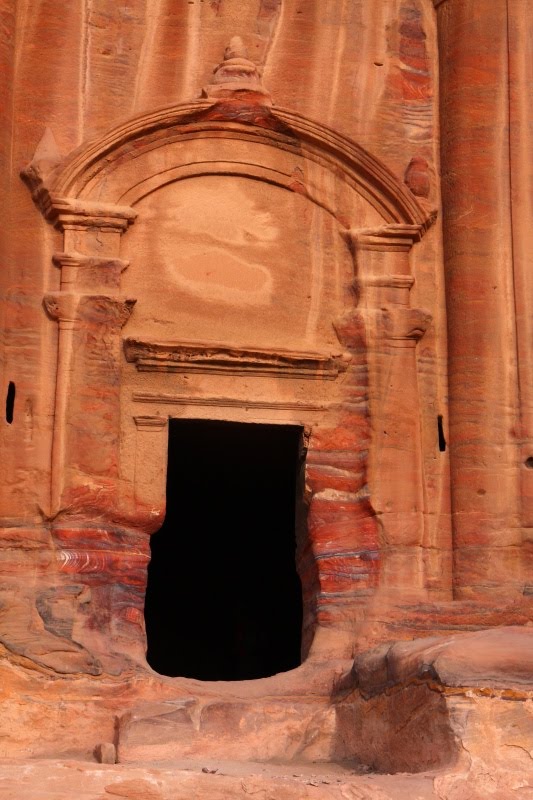Day 256. Petra
Петра – это галерея набатейского абстрактного искусства. Можно вечно бродить от алтарей к обелискам, от каменных плит к стелам и замирать перед каждым таким изображением бога. «Я не знаю, кому поклоняются арабы, но мне приходилось наблюдать их идолов в виде каменных блоков», - пишет греческий философ Максим Тирский во II веке нашей эры. Их трудно заметить за красотой величественных фасадов, но именно в них - в этих безликих каменных изваяниях - страннице удалось услышать голос древних жителей пустыни...
In the Greco-Roman world as well as the Parthian East, people have always accorded the gods with human form. The Nabataeans on the other hand represented their gods in the form of stelae. These stelae could take the form of rocks set upon end, blocks, or shapes carved into a stone wall, or elaborately carved square djin blocks set up at the entrance to their cities. (© Nabataea)
The Suda Lexicon, which was compiled at the end of the tenth century, refers to older sources which have since been lost. It states: “Theus Ares (Dushrara); this is the god Ares in Arabic Petra. They worship the god Ares and venerate him above all. His statue is an unworked square black stone. It is four foot high and two feet wide. It rests on a golden base. They make sacrifices to him and before him they anoint the blood of the sacrifice that is their anointment.”
In early Nabataean history, the Nabataeans had gods with Arabic names. Some of these were: (1) Al Qaum - the warrior god who guards the caravans, (2) Al Kutbay - the god of learning, commerce, writing, and divination (3) Allat - the goddess of spring and fertility (4) Al Uzza - the powerful and (5) Manawat - the god of destiny or fate. Later in Edom, they also adopted the Edomite god Dushara (Dushares) - lord of the mountains.
На фото - алтари в Малой Петре
As Hellenization began to take place around the Nabataean Empire, some archeologists feel that the Nabataeans began to identify their gods with Greek gods. Dushara was identified with Zeus, Al Kutbay with Hermes/Mercury. AlQaum with Ares/Mars, Manawat with Nemesis, Allat was with Athena/Minerva, and Al Uzza with Aphrodite, Urania/Venus, and Caelestis. Sometimes Allat was equated with Aphrodite, Urania/Venus and Caelestis as well. Al Uzza was also linked to the Egyptian goddess, Isis. Representations of Isis-Al Uzza are thought to be carved on the Treasury in Petra. During this time of Hellenization, Nabataean deities were sometimes depicted in figurative form like those of the Romans. Traditionally, however, Nabataeans worshiped their own gods in symbolic form such as square block or triangular baetyls, sacred meteorites, or abstract stone blocks or pillars, sometimes enhanced with schematic eyes and nose. (© Nabataea)
День 256. Петра
"Первыми племенами над Сирией, обитающими в Счастливой Аравии, являются набатеи и сабеи. Они нередко опустошали набегами Сирию, пока эту страну не подчинили римляне. В настоящее время и они, и сирийцы подвластны римлянам. Главный город набатеев — так называемая Петра, так как он расположен на гладком и ровном месте, но защищенном кругом скалой; с внешней стороны это место отвесное и крутое, а внутри находятся источники, богатые водой, годной как для домашнего употребления, так и для поливки садов. Местность за стенами города большей частью пустынна, в особенности же в сторону Иудеи. Здесь идет самый короткий путь — трехдневный или четырехдневный — до Гиерикунта, а до пальмовой рощи — 5 дней. Городом всегда управляет царь, происходящий из царского рода. У царя есть правитель — один из его друзей, которого называют «братом». Город имеет прекрасное государственное устройство. Афинодор, философ и мой спутник, которому случалось побывать у петрейцев, описывает их государственное устройство с удивлением. По его словам, он застал там множество римлян и других чужестранцев. Ему пришлось наблюдать там, как чужестранцы вели тяжбы друг с другом и с местными жителями, но местные жители никогда не обвиняли друг друга в суде, а жили между собой в полном мире." (Страбон (64/63 до н. э. — 23/24 н. э) "География" Кн. XVI )












Comments
Post a Comment